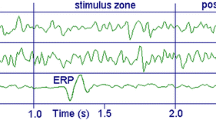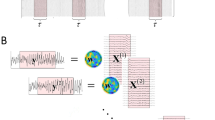Abstract
In the scope of EEG applications such as Brain Computer Interfaces (BCI) or the evaluation of epileptic activity, the detection of event-related potentials (ERP) and associated event-related desynchronization / synchronization (ERD/ERS) are common goals. The most commonly used method for assessing ERD/ERS consists on the evaluation of EEG power changes upon the event onset in relation to the baseline, reflecting increased/decreased synchronization. Phase synchronization measures have also been used for this purpose, both across event trials as well as between pairs of electrodes. Here, we propose a 2D spatially continuous extension of the Phase Locking Factor (PLF) metric for ERD/ERS quantification, called PLF Field (PLFF), based on measuring spatial variations of the EEG phase. A continuous phase map is estimated from the discrete set of EEG traces by using the Hilbert transform in the analytical signals framework. The synchronization at each arbitrary spatial location on the scalp space is then computed from the magnitude of the phase gradient at that location. The method is illustrated with EEG data obtained in two motor tasks paradigms. Our results indicate that the proposed approach is largely consistent with the conventional power-based ERD/ERS method, but may provide additional information in studies of neuronal synchronization using EEG.
Access this chapter
Tax calculation will be finalised at checkout
Purchases are for personal use only
Preview
Unable to display preview. Download preview PDF.
Similar content being viewed by others
References
Duncan, C., Barr, R., et al.: Event-related potentials in clinical research: Guidelines for eliciting, recording, and quantifying mismatch negativity, P300, and N400. Clinical Neurophysiology 120, 1883–1908 (2009)
Pfurtscheller, G., Lopes da Silva, F.H.: Event-related EEG/MEG synchronization and desynchronization: basic principles. Clinical Neurophysiology 110, 1842–1857 (1999)
Pfurtscheller, G.: Spatiotemporal Analysis of Alpha Frequency Components with the ERD Post-movement beta synchronization. A correlate of an idling motor area?; Pfurtcheller, G., Stanck Jr., A., Neuper, C.: Electroencephalography and Clinical Neurophysiology 98, 281–293 (1996)
Lopes da Silva, F.H.: Event-related neural activities: what about phase? Progress in Brain Research 159 (2006)
Lopes da Silva, F.H.: Event-related neural activities: what about phase?/. Prog. Brain Res. 159, 3–17 (2006)
Almeida, M., Schleimer, J.H., Bioucas-Dias, J.M., Vigário, R.: Source separation and clustering of Phase-Locked subspaces. IEEE 22(99) (2011)
Carreiras, C., de Almeida, L.B., Sanches, J.M.: Phase-Locking Factor in a Motor Imagery Brain-Computer Interface. In: 34th Annual International Conference of the IEEE Engineering in Medicine and Biology Society, San Diego, USA (August/September 2012)
Papoulis, A.: Probability, Random Variables, and Stochastic Processes. Mc-Graw Hill (1984)
Gáspár, C.: Multigrid technique for biharmonic interpolation with application to dual and multiple reciprocity method. Journal Numer-Algorithms 21(1-4), 165–183 (1999)
Moon, T.K., Stirling, W.C.: Mathematical methods and algorithms for signal processing. Prentice-Hall (2000)
Pfurtscheller, G., Neuper, C., Flotzinger, D., Pregenzer, M.: EEG-based discrimination between imagination of right and left hand movement. Electroencephalography and Clinical Neurophysiology 103(6), 642–651 (1997)
Author information
Authors and Affiliations
Editor information
Editors and Affiliations
Rights and permissions
Copyright information
© 2013 Springer-Verlag Berlin Heidelberg
About this paper
Cite this paper
Relvas, V., Sanches, J.M., Figueiredo, P. (2013). Scalp EEG Continuous Space ERD/ERS Quantification. In: Sanches, J.M., Micó, L., Cardoso, J.S. (eds) Pattern Recognition and Image Analysis. IbPRIA 2013. Lecture Notes in Computer Science, vol 7887. Springer, Berlin, Heidelberg. https://doi.org/10.1007/978-3-642-38628-2_73
Download citation
DOI: https://doi.org/10.1007/978-3-642-38628-2_73
Publisher Name: Springer, Berlin, Heidelberg
Print ISBN: 978-3-642-38627-5
Online ISBN: 978-3-642-38628-2
eBook Packages: Computer ScienceComputer Science (R0)





